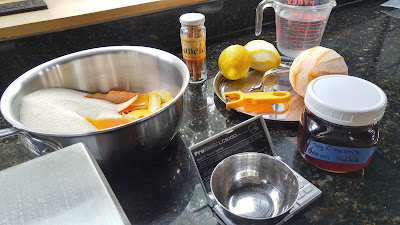Since we were working on our vermouths and chinatos we had the critical Cinchona -- quinine -- in powdered form. We made a tincture of 30g to 600 ml clean cheap Frïs vodka, a bit higher concentration than he uses, and strained through a coffee filter to produce a clear copper bitter elixir.
30 g Cinchona powder (mine's a very fine powder)
600 ml Vodka (clean-tasting)
Mix well, let sit a few hours, stir, and strain through a coffee filter -- this could take an hour or more
30 g Cinchona powder (mine's a very fine powder)
600 ml Vodka (clean-tasting)
Mix well, let sit a few hours, stir, and strain through a coffee filter -- this could take an hour or more
The rest of the recipe we followed pretty closely, adding a bit more citrus because denuding a grapefruit produced a bit more than the 30 g requested, and we had a half a lime lying around. We had the citric acid from Irene's cheese making and other kitchen experiments. It was pretty easy: simmer the aromatics with sugar and water; off heat, strain then add some of the quinine tincture. I've decreased the sugar a bit and added a little fresh ginger.
20 g Citric Acid
10 g Gentian Root
2 g Cinnamon, broken into pieces
30 g lemon zest (2 lemons)
30 g grapefruit zest (1 grapefruit)
15 g Ginger, fresh, sliced very thinly
350 g Sugar
500 ml Water
Bring the aromatics, sugar and water to boil, reduce heat, cover, simmer gently for 20 minutes.
Strain, cool.
Add 45 ml (1 1/2 ounces) of the Quinine Tincture to the cooled aromatic syrup.
Refrigerate up to 2 weeks.
20 g Citric Acid
10 g Gentian Root
2 g Cinnamon, broken into pieces
30 g lemon zest (2 lemons)
30 g grapefruit zest (1 grapefruit)
15 g Ginger, fresh, sliced very thinly
350 g Sugar
500 ml Water
Bring the aromatics, sugar and water to boil, reduce heat, cover, simmer gently for 20 minutes.
Strain, cool.
Add 45 ml (1 1/2 ounces) of the Quinine Tincture to the cooled aromatic syrup.
Refrigerate up to 2 weeks.
 |
| Straining simmered aromatics through sieve and coffee filter |
 |
| Measuring ingredients that went into the tonic syrup |
For a single drink, use 1 ounce tonic syrup, 3 ounce sparkling water, 1 1/2 ounce gin. Easy.
 |
| The payoff: beautiful, fresh-tasting G-n-T. |
It has a fresh citrus taste, Irene got orange right away. It's flavorful without the chemical taste of commercial tonics, and it's not nearly so sticky. We can also adjust the taste, perhaps lightening it up with a bit more sparkling water on hotter days.
Good stuff, not hard to make. Nice color too, but we haven't tested to see if it glows under blacklight. :-)


